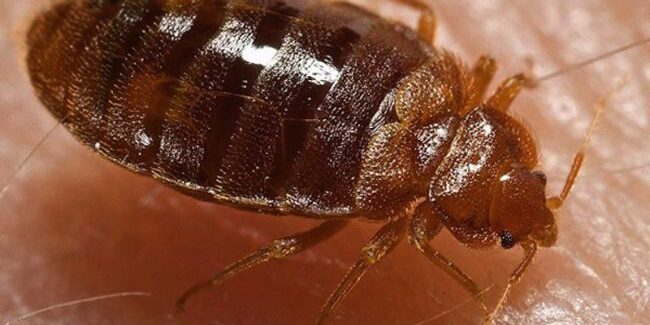Bed Bugs
The common Bed Bug (Cimex lectularius) has long been a pest – feeding solely on the blood of people and animals while they sleep. The bite of a these pests causes itchiness and irritation of their human and animal hosts. The Environmental Protection Agency (EPA), the Centers for Disease Control and Prevention (CDC), and the United States Department of Agriculture (USDA) all consider bed bugs a public health pest. However, unlike most public health pests, bed bugs are not known to transmit or spread disease.
Bed Bugs likely get their name from their habit of taking refuge in beds and feeding on humans while they sleep. These pests lurk in cracks and crevices and they’ve been living on human blood for centuries. They are flat, round and reddish brown, around a quarter-inch (7 millimeters) in length. The ones that typically plague humans are the common bedbug Cimex lectularius and the tropical bedbug Cimex hemipterus.

A bed bug nymph in the process of ingesting a blood meal.
(Image: © cdc.gov)
Bed Bugs don’t have wings and they can’t fly or jump. But their narrow body shape and ability to live for months without food make them ready stowaways and squatters. They are great “hitch hikers,” allowing them to travel long distances. They latch onto suitcases, clothes, and linens and can end up wherever these items are taken. This is why the spread of bed bugs occurs so easily. They also take shelter behind wallpaper and inside bedding, box springs and furniture. The ones that feed on people can crawl more than 100 feet (30 meters) in a night, but typically creep to within 8 feet (2.4 m) of the spot its human hosts sleep, according to the CDC.
Detection and Treatment
Bed Bug Identification
Bed Bugs are an oval shape and only grow to about 3/16th of an inch in length. They are sometimes mistaken for ticks, cockroaches, carpet beetles or other household insects. The immature bed bugs (nymphs) resemble the adults, but are smaller and lighter in color. Prior to feeding, they are brown and flat. After feeding, bed bugs become more red in color, swollen, and elongated. Bed bugs have 6 legs and 2 antennae.
As bed bugs grow they molt, shedding their skin five times before reaching maturity. A blood meal is needed between each successive molt. Adult females also must feed in order to lay eggs. Under favorable conditions (70-80°F), the bugs can mature fully in as little as a month, producing multiple generations per year. Cooler temperatures or limited access to blood prolong the development time.
Bed Bug Infestation Signs
Bed Bugs are most easily identified by small reddish-brown fecal spots on mattresses, upholstery or walls. If these spots are found, it can indicate an infestation. Bites on the arms and legs are also a tell-tale sign of bed bugs. While these bites can be small, if they swell and become itchy, they are noticeable. It can take two to three days for these bites to appear, allowing the infestation to grow. However, bites alone do not indicate an infestation without other bed bug evidence.
Infestations can also be identified by sightings of bed bug molt skins, their eggs, empty eggshells, or the bugs themselves. All of these things are quite small, but still visible to the human eye. Bed bug molt skins as well as their eggshells appear pale white after molting or emerging from the eggshell, respectively.
Treatment
Bed Bugs are extremely elusive creatures so professional help should be sought out when dealing with an infestation. They can be very difficult pest to treat. The Bug Man, Inc has several Pest Control options available, including pet-friendly treatments. Pricing and treatment all depend on your needs and degree of infestation. Contact The Bug Man, Inc today, for your free no-charge consultation.
ARTICLE SOURCES: epa.gov | cdc.gov | livescience.com | pestworld.org





